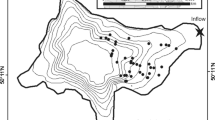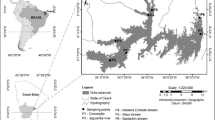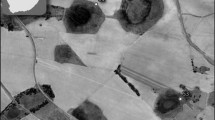Abstract
Although the ecological effects of surface wateracidification are now well researched, factorscontrolling the abundance and occurrence of aquaticorganisms in unpolluted acid-sensitive systems arepoorly known. The Høylandet region in central Norwayexperiences relatively low levels of atmosphericpollution and its surface waters, although acid, arenot significantly acidified. Hence lakes and streamsin this region were selected to study the influence ofwater chemistry on diatom algae. Relationships betweenthe two were explored using the multivariate techniqueof canonical correspondence analysis (CCA). Theprincipal water chemistry variables influencingspecies composition of periphytic diatoms were foundto be pH and water colour. Furthermore, therelationship between species abundance and pH wassufficiently strong to enable reconstruction of wateracidity from diatom data. Establishing the nature ofaquatic communities in atmospherically clean butgeologically sensitive regions is an important meansof identifying control systems against which therecovery of acidified lakes in polluted regions can beassessed. The Høylandet region has the potential toprovide a Europe-wide control system of this naturebut much further work is required to follow up andextend the results of this preliminary study.
Similar content being viewed by others
References
Battarbee, R. W., 1984, Diatom analysis and the acidification of lakes. Phil. Trans. r. Soc. Lond. B 305: 451–477.
Battarbee, R. W., 1986, Diatom analysis. In Berglund, B. E. (ed.), Handbook of Holocene Palaeoecology and Palaeohydrology. J. Wiley & Sons, Chichester: 527–570.
Battarbee, R. W., N. J. Anderson, P. G. Appleby, J. Flower, S. C. Fritz, E. Y. Haworth, S. Higgitt, V. J. Jones, A. Kreiser, M. A. R. Munro, J. Natkanski, F. Oldfield, S. T. Patrick, P. J. Raven, N. G. Richardson, B. Rippey & A. C. Stevenson, 1988. Lake Acidification in the United Kingdom. ENSIS, London.
Berge, F., 1985. Relationships of diatom taxa to pH and other environmental factors in Norwegian soft-water lakes. Unpubl. Ph.D thesis, University of Maine, USA.
Berge, F., Y-W. Brodin, G. Cronberg, F. El-Daoushy, H. I. Høeg, J. P. Nilssen, I. Renberg, B. Rippey, S. Sandøy, A. Timberlid & M. Wik, 1990. Palaeolimnological changes related to acid deposition and land-use in the catchments of two Norwegian soft-water lakes. Phil. Trans. r. Soc. Lond. B 327: 385–389.
Birks, H. J. B., 1987. Methods for pH calibration and reconstruction from palaeolimnological data: procedures, problems, potential techniques. Proceedings Surface Water Acidification Programme (SWAP) Mid-Term Review Conference. Bergen 22–26 June 1987: 370–380.
Birks, H. J. B., J. M. Line, S. Juggins, A. C. Stevenson & C. J. F. ter Braak, 1990. Diatoms and pH reconstruction. Phil. Trans. r. Soc. Lond. B 327: 263–278.
Charles, D. F., 1984. Recent pH history of BigMoose Lake (Adirondack Mountains, NewYork, USA) inferred from sediment diatom assemblages. Int. Ver. Theor. Angew. Limnol. 22: 559–566.
Charles, D. F., 1985. Relationships between surface diatom assemblages and lakewater characteristics in Adirondack lakes. Ecology 66: 994–1011.
Christophersen, N., R. D. Vogt, C. Neal, H. A. Anderson, R. C. Ferrier, J. D. Miller & H. M. Seip, 1990. Controlling mechanisms for stream water chemistry at the pristine Ingabekken site in mid-Norway: Some implications for acidification models, Wat. Res. Res. 26: 59–67.
Cleve-Euler, A., 1951–1955. Die diatomeen von Schweden und Finnland. Kungl. Svenska. Vetensk. Handl. Fjärde Ser. 2: 13–163, 4:1 3–158, 4:5 3–255, 5:4 3–231, 3:3 3–153.
Davis, R. B., S. A. Norton, C. T. Hess & D. F. Braake, 1983. Palaeolimnological reconstruction of the effects of atmospheric deposition of acids and heavymetals on the chemistry and biology of lakes in New England and Norway. Hydrobiologia 103: 113–123.
Davis, R. B., D. S. Anderson & F. Berge, 1985. Palaeolimnological evidence that lake acidification is accompanied by loss of organic matter. Nature. 316: 436–438.
Drablö, D. & A. Tollan (eds), 1980. Ecological impact of acid precipitation: proceedings of an international conference, Sandefjord, Norway. SNSF Project, Oslo.
Flower, R. J., 1986. The relationship between surface sediment diatom assemblages and pH in 33 Galloway lakes: some regression models for reconstructing pH and their application to sediment cores. Hydrobiologia 143: 93–105
Flower, R. J., R. W. Battarbee & P. G. Appleby, 1987. The recent palaeolimnology of acid lakes in Galloway, southwest Scotland: diatom analysis, pH trends and the role of afforestation. J. Ecol. 75: 797–824.
Flower, R. J., S. Juggins & R.W. Battarbee, 1997. Matching diatom assemblages in lake sediment cores and modern surface sediment samples; the implication for lake conservation with special reference to acidified systems. Hydrobiologia, 344: 27–40.
Fritz, S. C., A. M. Kreiser, P. G. Appleby & R. W. Battarbee, 1990. Recent acidification of upland lakes in north Wales: palaeolimnological evidence. In Edwards, R. W. et al. (eds), Acid Waters In Wales. Kluwer Academic Publishers, Dordrecht: 27–37.
Gauch, H. G. & G. B. Chase, 1974. Fitting the Gaussian curve to ecological data. Ecology 55: 1377–1381.
Harriman, R. & B. R. S. Morrison, 1982. The ecology of streams draining forested and non-forested catchments in an area of central Scotland subject to acid precipitation. Hydrobiologia 88: 251–263.
Harriman, R., B. R. S. Morrison, L. A. Caines, P. Collen & A. W. Watt, 1987. Long term changes in fish populations of acid streams and lochs in Galloway, south-west Scotland. Wat. Air Soil Pollut. 32: 89–112.
Hustedt, F., 1927-1966. Die Kieselalgen Deutchlands, Österreichs und der Schweiz mit Berucksichtigung der übrigen Länder Europas sowie der angrenzenden Meersgebeite. Kryptogramen-Flora. 7, vol. 1 (1927–1930), 2 (1931–1959), 3 (1961–1966). Geest and Portig, Leipzig.
Hustedt, F., 1930. Baccillariophyta (diatomeae), die susswasserflora von Mitteleuropas. In Pascher, A. (ed.), Fischer, Jena, Vol. 10.
Hustedt, F., 1937-1939. Systematische undökologische Untersuchungen über den Diatomeen-flora von Java, Bali und Sumatra. Arch. Hydrobiologia (suppl.) 15/16.
Jongman, R. H. G., C. J. F. ter Braak & O. F. R. van Tongeren, 1987. Data analysis in community and landscape ecology. Pudoc, Wageningen.
Meriläinen, J., 1967. The diatom flora and hydrogen ion concentration of the water. Ann. Bot. fenn. 4: 51–58.
Muniz, I. P., 1987. Some recent observations on regional water chemistry, fish and aquatic animals from lakes and streams in the Høylandet area: a preliminary report. Proceedings Surface Water Acidification Programme (SWAP) Mid-Term Review Conference. Bergen: 259–265.
Muniz, I. P. & E. Framstad, 1997. Surface water chemistry characteristics in the Lake Stor Grønningen drainage area, Høylandet, during periods of high and low discharge. Hydrobiologia 348: 49–68.
Nygaard, G., 1956. Ancient and recent flora of diatoms and Chrysophyceae in Lake Gribs. In Berg, K. & J. C. Petersen (eds), Studies on the Humic Acid Lake Grisbo. Folia limnol. Scand. 8: 32–94.
Patrick, S., D. T. Monteith & A. Jenkins, 1995. UK Acid Water Monitoring Network: The first Five Years–Analysis and Intepretation of Results April 1988–March 1993. Report for the Department of the Environment (UK). ENSIS Publishing, London.
Renberg, I. & T. Hellberg, 1982. The pH history of lakes in southwestern Sweden as calculated from the subfossil diatom flora of the sediments. Ambio. 11: 30–33.
Stevenson, A. C., H. J. B. Birks, R. J. F. Flower & R. W. Battarbee, 1989. Diatom-based pH reconstruction of lake acidification using canonical correspondence analysis. Ambio 18: 228–233.
ter Braak, C. J. F., 1986. Canonical Correspondence Analysis: a new eigenvector method for multivariate direct gradient analysis. Ecology 67: 1167–1179.
ter Braak, C. J. F., 1987a. Unimodal models to relate species to environment. Thesis, Agricultural University of Wageningen.
ter Braak, C. J. F., 1987b. CANOCO–A FORTRAN program for canonical community ordination by (partial) (detrended) (canonical) correspondence analysis, principal components analysis and redundancy analysis (version 2.1). TNO Institute of Applied Computer Science, Wageningen.
United Kingdom Acid Waters Review Group (UKAWRG), 1988. Acidity in United Kingdom Freshwaters. Second Report of the UK Acid Waters Review Group to the Department of Environment, London.
Vogt, R. D. & I. P. Muniz, 1997. Soil and stream water chemistry in a pristine and boggy site in mid-Norway. Hydrobiologia 348: 19–38.
Wik, M. & J. Natkanski, 1990. British and Scandinavian lake sediment records of carbonaceous particles from fossil-fuel combustion. Phil. Trans. r. Soc. Lond. B 327: 319–323.
Author information
Authors and Affiliations
Rights and permissions
About this article
Cite this article
Battarbee, R.W., Flower, R.J., Juggins, S. et al. The relationship between diatoms and surface water quality in the Høylandet area of Nord-Trøndelag, Norway. Hydrobiologia 348, 69–80 (1997). https://doi.org/10.1023/A:1003085116632
Issue Date:
DOI: https://doi.org/10.1023/A:1003085116632




